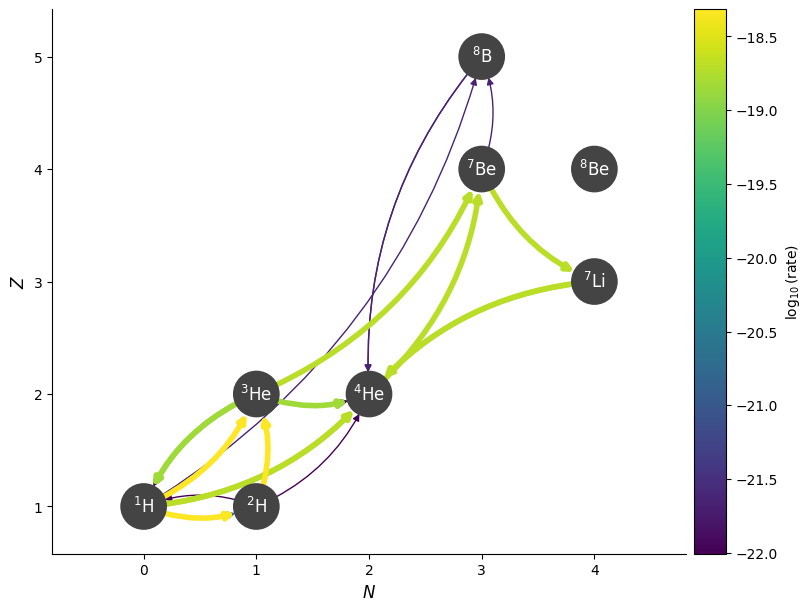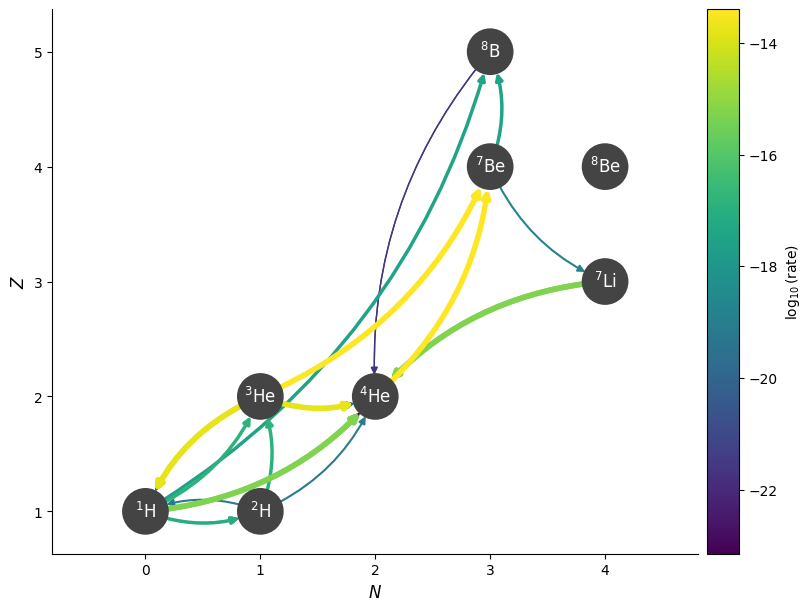PP Chains#
There are multiple proton-proton chains.
PP-I involves: \(p\), \(d\), \({}^3\mathrm{He}\), \({}^4\mathrm{He}\)
PP-II adds: \({}^7\mathrm{Li}\), \({}^7\mathrm{Be}\)
PP-III adds: \({}^8\mathrm{Be}\), \({}^8\mathrm{B}\)
Here we can explore them all.
Creating a network#
We’ll use pynucastro to create a network with all of these nuclei.
import pynucastro as pyna
net = pyna.network_helper(["p", "d", "he3", "he4",
"li7", "be7", "be8", "b8"])
warning: He4 was not able to be linked in TabularLibrary
warning: d was not able to be linked in TabularLibrary
warning: B8 was not able to be linked in TabularLibrary
warning: Li7 was not able to be linked in TabularLibrary
warning: p was not able to be linked in TabularLibrary
warning: He3 was not able to be linked in TabularLibrary
warning: Be8 was not able to be linked in TabularLibrary
warning: Be7 was not able to be linked in TabularLibrary
Note
ReacLib does not provide the rate for \({}^8\mathrm{Be} \rightarrow \alpha + \alpha\) because it is so short lived. It essentially will break apart into two \(\alpha\) immediately. It instead has a rate that combines:
Approximating composition in Sun’s core#
We need a reasonably accurate estimate for the composition in the core of the Sun. We’ll find this by integrating an initial H/He mix for 4.5 billion years–this should find an equilibrium
tmax = 4.5e9 * 365.25 * 24 * 3600
tmax
1.420092e+17
net.write_network("pp.py")
import pp
/opt/hostedtoolcache/Python/3.13.9/x64/lib/python3.13/site-packages/pynucastro/rates/derived_rate.py:135: UserWarning: He3 partition function is not supported by tables: set pf = 1.0 by default
warnings.warn(UserWarning(f'{nuc} partition function is not supported by tables: set pf = 1.0 by default'))
/opt/hostedtoolcache/Python/3.13.9/x64/lib/python3.13/site-packages/pynucastro/rates/derived_rate.py:135: UserWarning: d partition function is not supported by tables: set pf = 1.0 by default
warnings.warn(UserWarning(f'{nuc} partition function is not supported by tables: set pf = 1.0 by default'))
/opt/hostedtoolcache/Python/3.13.9/x64/lib/python3.13/site-packages/pynucastro/rates/derived_rate.py:135: UserWarning: Be7 partition function is not supported by tables: set pf = 1.0 by default
warnings.warn(UserWarning(f'{nuc} partition function is not supported by tables: set pf = 1.0 by default'))
/opt/hostedtoolcache/Python/3.13.9/x64/lib/python3.13/site-packages/pynucastro/rates/derived_rate.py:135: UserWarning: B8 partition function is not supported by tables: set pf = 1.0 by default
warnings.warn(UserWarning(f'{nuc} partition function is not supported by tables: set pf = 1.0 by default'))
/opt/hostedtoolcache/Python/3.13.9/x64/lib/python3.13/site-packages/pynucastro/rates/derived_rate.py:135: UserWarning: Li7 partition function is not supported by tables: set pf = 1.0 by default
warnings.warn(UserWarning(f'{nuc} partition function is not supported by tables: set pf = 1.0 by default'))
We’ll integrate this using solve_ivp
import numpy as np
from scipy.integrate import solve_ivp
X0 = np.zeros(pp.nnuc)
X0[pp.jp] = 0.72
X0[pp.jhe4] = 0.28
Y0 = X0 / pp.A
rho = 150
T = 1.5e7
sol = solve_ivp(pp.rhs, [0, tmax], Y0, method="BDF", jac=pp.jacobian,
dense_output=True, args=(rho, T), rtol=1.e-7, atol=1.e-12)
Now let’s get the composition at the final time
X_final = sol.y[:, -1] * pp.A
X_final
array([2.81318714e-01, 2.04411172e-18, 8.77279202e-06, 7.18672513e-01,
2.03687202e-15, 9.99888210e-12, 4.53092291e-54, 1.95666221e-21])
and create a pynucastro Composition from this
comp = pyna.Composition(net.unique_nuclei)
comp.set_array(X_final)
print(comp)
X(p) : 0.28131871449282164
X(d) : 2.0441117249462732e-18
X(He3) : 8.772792020130378e-06
X(He4) : 0.7186725127051565
X(Li7) : 2.0368720231888285e-15
X(Be7) : 9.998882102842114e-12
X(Be8) : 4.530922913017406e-54
X(B8) : 1.956662207786176e-21
Importance of PP-I vs. PP-II#
We can evaluate the rates with this composition
r_sun = net.evaluate_rates(rho, T, comp)
/opt/hostedtoolcache/Python/3.13.9/x64/lib/python3.13/site-packages/pynucastro/rates/derived_rate.py:135: UserWarning: He3 partition function is not supported by tables: set pf = 1.0 by default
warnings.warn(UserWarning(f'{nuc} partition function is not supported by tables: set pf = 1.0 by default'))
/opt/hostedtoolcache/Python/3.13.9/x64/lib/python3.13/site-packages/pynucastro/rates/derived_rate.py:135: UserWarning: d partition function is not supported by tables: set pf = 1.0 by default
warnings.warn(UserWarning(f'{nuc} partition function is not supported by tables: set pf = 1.0 by default'))
/opt/hostedtoolcache/Python/3.13.9/x64/lib/python3.13/site-packages/pynucastro/rates/derived_rate.py:135: UserWarning: Be7 partition function is not supported by tables: set pf = 1.0 by default
warnings.warn(UserWarning(f'{nuc} partition function is not supported by tables: set pf = 1.0 by default'))
/opt/hostedtoolcache/Python/3.13.9/x64/lib/python3.13/site-packages/pynucastro/rates/derived_rate.py:135: UserWarning: B8 partition function is not supported by tables: set pf = 1.0 by default
warnings.warn(UserWarning(f'{nuc} partition function is not supported by tables: set pf = 1.0 by default'))
/opt/hostedtoolcache/Python/3.13.9/x64/lib/python3.13/site-packages/pynucastro/rates/derived_rate.py:135: UserWarning: Li7 partition function is not supported by tables: set pf = 1.0 by default
warnings.warn(UserWarning(f'{nuc} partition function is not supported by tables: set pf = 1.0 by default'))
Let’s look at just the rates that consume \({}^3\mathrm{He}\)
for r in r_sun:
if pyna.Nucleus("he3") in r.reactants:
print(f"{str(r):30}: {r_sun[r]:12.6g}")
He3 + p ⟶ He4 + e⁺ + 𝜈 : 2.73268e-26
He3 + He4 ⟶ Be7 + 𝛾 : 1.97861e-19
He3 + H2 ⟶ p + He4 : 9.85879e-23
He3 + He3 ⟶ p + p + He4 : 1.42325e-19
Be7 + He3 ⟶ p + p + He4 + He4 : 2.64203e-39
He3 ⟶ p + H2 : 0
Notice that the rate of \({}^3\mathrm{He}({}^3\mathrm{He},pp){}^4\mathrm{He}\) is only slightly slower than \({}^4\mathrm{He}({}^3\mathrm{He},\gamma){}^7\mathrm{Be}\) at this point.
r33 = net.get_rate_by_name("he3(he3,pp)he4")
r34 = net.get_rate_by_name("he4(he3,g)be7")
ratio = r_sun[r33] / r_sun[r34]
ratio
np.float64(0.7193207261903833)
fig = net.plot(rho, T, comp,
curved_edges=True,
always_show_alpha=True,
always_show_p=True,
ydot_cutoff_value=1.e-25)

Now let’s consider a bit hotter. We’ll keep the same composition
T = 3.5e7
fig = net.plot(rho, T, comp,
curved_edges=True,
always_show_alpha=True,
always_show_p=True,
ydot_cutoff_value=1.e-25)

r_hot = net.evaluate_rates(rho, T, comp)
ratio_hot = r_hot[r33] / r_hot[r34]
ratio_hot
np.float64(0.41694689409397745)
Now we see that \({}^4\mathrm{He}({}^3\mathrm{He},\gamma){}^7\mathrm{Be}\) is much faster.
Overall, as the temperature increases, we see that the \({}^4\mathrm{He}({}^3\mathrm{He},\gamma){}^7\mathrm{Be}\) rate is more active.
Note
These rates are strongly dependent on the amount of \({}^3\mathrm{He}\) present, so we should really compute the equilibrium abundance before making the comparisons.

